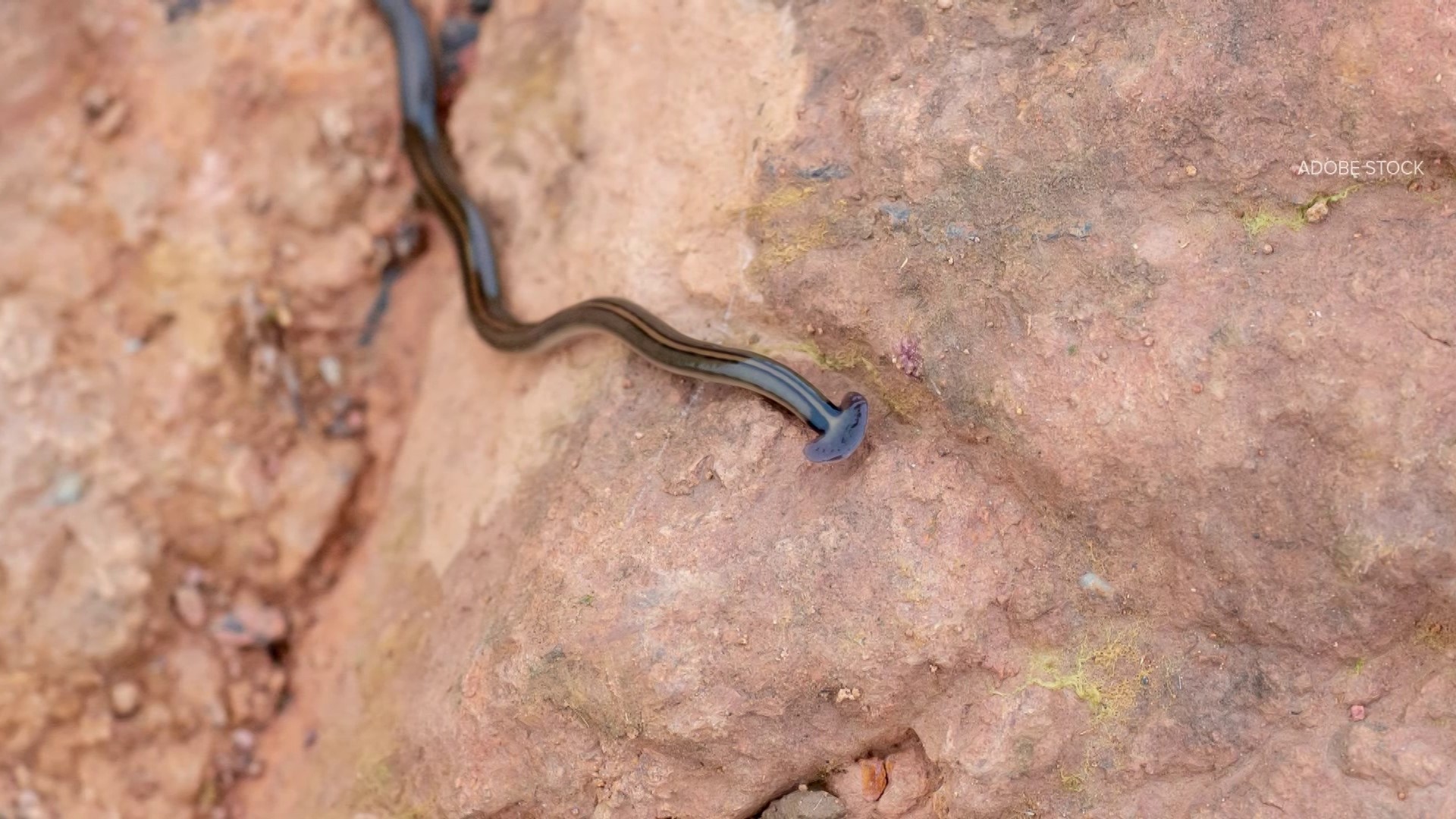FAYETTEVILLE, Ark — Hammerhead worms are not new to the Natural State, but a rise in sightings is leading to several questions about the invasive species.
Experts with the University of Arkansas (U of A) System Division of Agriculture say that the worms have been reported in at least 10 Arkansas counties, including parts of Northwest Arkansas and the River Valley.
What is a hammerhead worm?
According to the U of A, it's a complex of species in several genera known as planarians, or terrestrial flatworms. Though native to tropical and subtropical Southeast Asia, hammerhead worms have become invasive worldwide, and have been reported in Arkansas for at least a decade.
The worms prefer to live in warmer climates, similar to Arkansas. They require moist conditions, but can also survive in cooler conditions like under rocks, logs or thick vegetation. They tend to avoid the light and can usually be found resting in cool, damp locations during the day and prefer to move and feed at night.
“The worms are thought to have been accidentally transported in soil through the global horticultural trade,” said Jon Zawislak, extension apiarist for the University of Arkansas System Division of Agriculture. “These flatworms prefer warm climates and feel right at home in the southeastern United States.”
Experts say hammerhead worms are considered highly invasive and pose a potential threat to local earthworm populations, as well as gastropods such as slugs and snails.
How do I spot one?
Did you find a big worm but aren't sure if it's a hammerhead?
The most visually distinctive characteristic of these worms is their broad, spade‐shaped head.
According to the U of A, bipalium kewense has a long flattened body that typically grows to eight to 12 inches, and sometimes even longer. They are light-colored and have one to five dark, thin dorsal stripes.
Experts say these worms are carnivorous and will prey on insect larvae, slugs, snails and various earthworm species. Hammerhead worms are also known to cannibalize each other and can store food reserves in their bodies, surviving several weeks without eating.
I found one, now what?
Did you come across one of these slimy creatures while working in your garden? Don't barehand this big boy, use gloves if you handle it!
Experts say many species of hammerhead worms contain a potent neurotoxin called tetrodotoxin, which is the same toxin found in pufferfish. They use to immobilize their prey and defend against predators. When they secrete this substance, it can irritate your skin if you come into contact with it and will sicken pets if eaten.
As a precaution, gardeners should never handle these worms without gloves.
Hammerhead worms are hermaphrodites and can mate with any member of their species, but more often reproduce asexually by breaking off into smaller pieces, according to experts from the U of A.
“Like many other planarians, if cut into pieces, these creatures can regenerate each part into a whole fully‐developed worm within a couple of weeks,” Zawislak said. “If injured, they can quickly regenerate damaged tissue. These worms regularly break off pieces of their tails as they move along, leaving a bit behind to become a new worm. This ability likely contributes to their success in colonizing new habitats.”
How do I get rid of the hammerhead worm?
Experts say don't hesitate to kill this invasive species, but there's a specific way to do so.
Don't chop the worm into pieces with a garden spear (or any other sharp object). It's recommended that you instead use gloves to put the worm into a plastic bag or another type of container with salt and vinegar. Once the worm is secured in the bag, put it into the freezer overnight, then dispose of it the next day.
Because of their ability to reproduce by fragmenting and their lack of natural enemies in North America, experts say hammerhead worms will likely prove impossible to control.
“They disperse slowly on their own but are probably spread by people more rapidly than we are aware,” Zawislak said. “Worms can be transported with potted plant nursery stock, in truckloads of topsoil or by construction earthmoving equipment. There’s no economically feasible method to monitor, control or eradicate these invasive worms. Hammerhead worms do have the potential to upset the ecosystem by preying on beneficial worms as well as slugs and snails,” he said. “But since they are also cannibalistic, they may prove to be their own worst enemies.”
Where can I find these reported sightings?
Arkansans can report any suspected invasive species to the Arkansas Department of Agriculture's Cooperative Agriculture Pest Survey office online.
The citizen science project, iNaturalist, is working to keep a catalog of all living things. If you spot one of these hammerhead worms in Arkansas, you can report it here, which will help track the spread of the invasive species.
According to a map from iNaturalist, hammerhead worm sightings have been reported across Northwest Arkansas and in parts of the River Valley.
DOWNLOAD THE 5NEWS APP
DOWNLOAD FOR IPHONE HERE | DOWNLOAD FOR ANDROID HERE
HOW TO ADD THE 5NEWS APP TO YOUR STREAMING DEVICE
ROKU: add the channel from the ROKU store or by searching for KFSM in the Channel Store.
For Fire TV, search for "KFSM" to find the free app to add to your account. Another option for Fire TV is to have the app delivered directly to your Fire TV through Amazon.
To report a typo or grammatical error, please email KFSMDigitalTeam@tegna.com.

